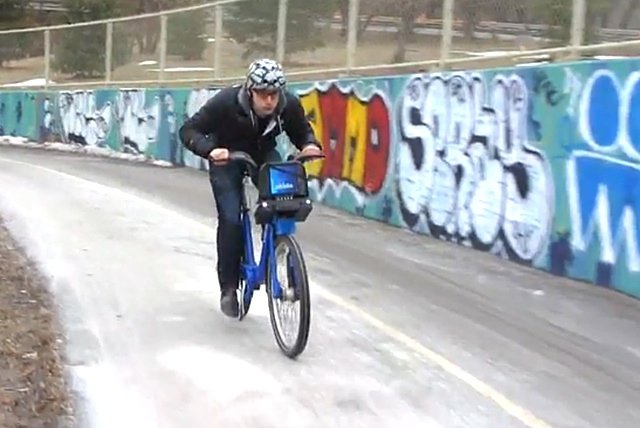Test-Driving ShareRoller, The Electric Motor That Could Make Citi Bike Go Vroom
March 10, 2014, 10:08 a.m.
Perhaps we judged this invention a little too hastily.

ShareRoller, as we previously noted, is a new invention that seeks to turn your Citi Biking experience into a motorized one. Our first reaction to the modification, which could propel your Citi Bike to speeds approaching 18 mph, was one of breezy derision, but that was before we actually tried it. Last week, inventor Jeff Guida came by the office to let us test it; here he is showing us how quickly the ShareRoller can be installed:
Resident stuntman Jake Dobkin took the ShareRoller out for a spin, and, well, he's seen the light:
I kind of thought this was a silly idea when I saw the Kickstarter page, but after a test-drive up over the Manhattan Bridge path from DUMBO, I'm a ShareRoller convert.
Attaching the motor seems fast and straight-forward: you just flip the roller out and slide the box onto the front of the bike. And the attachment felt secure: I rode the bike over a couple of blocks of DUMBO cobblestones and it didn't feel like it was shaking or about to pop off.
There is only one control on the handlebar attachment: a small plunger you push in to accelerate. It only took me a minute to get used to it: you gently push it in, adding speed, until you can't push it in any more. After a block, I was ready to go.
I was surprised how much power it gave me on the hill leading up to the bridge: at full power, I hardly had to peddle to summit the hill. Going up the bridge hill was similar—at first, I was using it to supplement my own pedaling, but toward the top I stopped pedaling and just coasted on its power, and it had no problem taking me over the summit. It was fun to roar over the top of the hill like Mad Max in Welcome to the Thunderdome, except on a Citi Bike.
I've biked up the Manhattan Bridge on Citi Bike once before without a motor: I wouldn't recommend it. The bike is heavy, and you end up feeling like you're going to have a heart attack. Also, it's embarrassing as everyone passes you. But with ShareRoller, I didn't feel the weight—it was as easy as going over on my regular lightweight bike. Easier, even; I didn't feel out of breath at the top at all.
I don't see this as being a tool to avoid exercise. It seems like something that commuters would use to help on routes that have really hard uphills, like the bridges. I can understand why someone wearing work clothes would appreciate not getting totally sweaty coming in to work, and the power isn't so much that you feel like you're riding a motorcycle and don't feel any pressure to peddle.
In conclusion, I was very impressed by the design, construction, and operation of this product, and I hope it reaches its Kickstarter goal. It may not be for everyone, but it feels like a useful product for a portion of the bicycling public.
Thanks for the fair-minded review, Jake! Here's a video of him hauling ass up the Manhattan Bridge:
Now back to our original qualms: will the city actually let anyone modify Citi Bikes in any way? "That remains to be seen," Guida told me after Jake took his eye-opening joyride. "Modifications are not allowed, but people do it all the time. People put lights on the CitiBikes, people put bags on it. This is what bike-share people want. London is converting to electric bike stations for hilly areas."
Guida has put in over 1500 hours of work in the invention, and says he's racked up over $1000 in fines for keeping his Citi Bike out too long during experiments. "Why do we have to combine commuting with exercise?" Guida asks. "We don't call people who take the train lazy, and we shouldn't call people who use a motor on their bike a lazy sloth."
As for electric bikes being illegal in NYC, Guida insists "electric bikes are not all illegal in NYC. Local Law 40 provides exemptions for electric powered bikes that require rider assistance. Since the ShareRoller requires one to be going 1-2 mph before the motor will kick in (one pedal stroke), it's not technically capable of propelling the device without human power, and is therefore designed to be exempt from Local Law 40." Whether city officials and law enforcement will see it that way remains to be seen.
I also asked Guida about the incentive bikers will have to run lights, now that they have the horsepower to actually beat them. "People beat the light because they don't want to give up their momentum," Guida argues. "The motor would actually encourage people to become more comfortable with stopping, because they wouldn't have to work so hard to get going at a good speed again."
Guida's Kickstarter has already hit $30,000 of its $100,000 goal. You can donate to its development here.
Citi Bike reps did not respond to a request for comment about the invention.